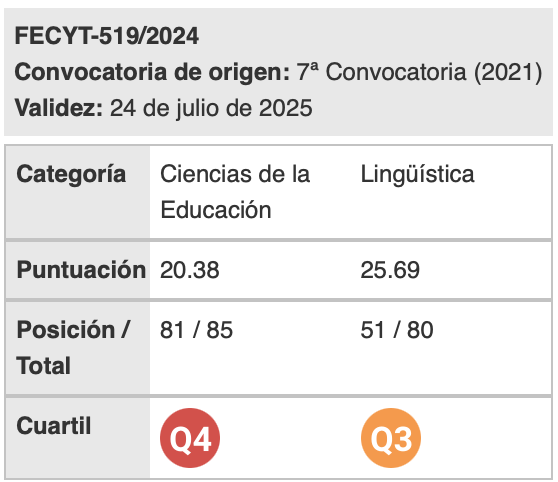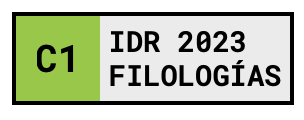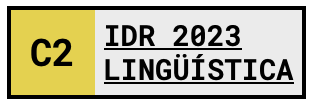Are we talking about the same thing? Comparative study of language programmes for specific purposes in two universities in the United States and Spain
Keywords:
languages for specific purposes, linguistics, applied linguistics, specialised discourse, discourse studies, pragmatics, language teaching, translation, interpreting, English for specific purposes, pedagogyAbstract
Language courses for specific purposes vary due to their context and purpose. However, it is possible to find common features between programs in two different countries, with different characteristics and languages in question. It is interesting then toobserve how different courses work according to their specific characteristics to highlight in addition to their similarities their limitations and challenges. In this sense, this paper addresses the cases of Spanish for specific purposes in the Faculty of Foreign Languages of Valdosta State University in the United States and English in the Faculty of Education of the University of Alcalá in Spain. The contrastive study refers to the characteristics of both programs, their courses and students, the methodology and materials used for instruction, the use of the target language and evaluation. The paper concludes that in spite of the different nature of the programs and courses in question, more similarities can be found than differences of substance, so that future studies will address these contrasts in the elaboration of an international common framework.
Downloads
References
Baron, D. (nd). The legendary English-only vote of 1795. Official American English only. Public Broadcasting Service. <http://www.english.illinois.edu/-people-/faculty/debaron/essays/ legend.htm> [3/3/2017]
Bartanusz, S., & Sulova, L. (2003). Functional analysis of the communication between the young child and his father or mother when reading an illustrated book. European Journal of Psychology of Education, 18(2), 113-134.
Barton, D. & Hamilton, M. (1998). Local literacies: Reading and writing in one community. London: Routledge.
Basturkmen, H. (2010). Developing Courses in English for Specific Purposes. London, UK: Palgrave Macmillan.
Corder,S. P. (1973). Introducing Applied Linguistics. Harmonds Worth: Penguin.
DeCarlo, M. J. T. (1994). Communicative functions of speech in a monolingual kindergarten. Working Papers in Educational Linguistics, 10(1), 22-31.
Flowerdew, J., & Peacock, M. (2001). The EAP curriculum: Issues, methods, and challenges. In J. Flowerdew & M. Peacock (Eds.), Research perspectives on English for academic purposes (pp. 177-194). Cambridge: CUP.
García Laborda, J. (2011). Revisiting materials for teaching Languages for Specific Purposes. 3L The Southeast Asian Journal of English Language Studies, 17 (1), 102-112.
García Laborda, J. (2013). Reacciones iniciales de los profesores a la preparación de la prueba informatizada de acceso a la universidad. Lenguaje y Textos, 38, 133-140.
García Laborda, J. y García Esteban, S. (2016). Human communicative dialogic practices in content and language-based educational interactions with technology. The Anthropologist, 25(3), 220-228.
García Laborda, J., & Litzler, M.F. (2015). Current approaches in teaching English for Specific Purposes. Revista Onomázein, 31, 38-51.
García Laborda, J., & Litzler, M.F. (en prensa). English for Business: Student Responses to Language Learning through Social Networking Tools. ESP Today.
García Laborda, J., Bejarano,L.G., y Simons, M. (2012). ¿Cuánto aprendí en la secundaria? Las actitudes de los estudiantes universitarios de primer año respecto a la relación enseñanza-aprendizaje de su segunda lengua en la escuela secundaria en tres contextos internacionales. Educación XX1, 15(2), 159-184.
Hyland, K. (2004). Genre and Second Language Writing. Ann Arbor: University of Michigan Press.
Howatt, A. P. R. (1984). A History of English Language Teaching. Oxford: Oxford University Press.
Hutchinson, T., & Waters, A. (1987). English for specific purposes: A learning-centred approach. Cambridge: Cambridge University Press
Ijsewijn, J. (2007). Latin as lingua franca: Renaissance Humanism and translation. En H.. Kittel Kittel, H., Frank, A. P., Greiner, N., Hermans, T,., Koller, W., Lambert, J., y Paul, F. (Eds.), An international encyclopedia of translation studies. (pp. 1429‒1435), New York: De Gruyter.
Johns, A. M. (2002). Genre in the classroom: Multiple perspectives. Mahwah, NJ: Lawrence Erlbaum.
Long, M. (2005). Second language needs analysis. Cambridge, UK: Cambridge University Press.
Sánchez-López, L. (2010). El español para fines específicos: La proliferación de programas creados para satisfacer las necesidades del siglo XXI. Hispania, 93(1), 85-89.
Downloads
Published
How to Cite
Issue
Section
License
Authors who publish with this journal agree to the following terms:
- Authors retain copyright and grant the journal right of first publication with the work simultaneously licensed under a Creative Commons Attribution License that allows others to share the work with an acknowledgement of the work's authorship and initial publication in this journal.
- Authors are able to enter into separate, additional contractual arrangements for the non-exclusive distribution of the journal's published version of the work (e.g., post it to an institutional repository or publish it in a book), with an acknowledgement of its initial publication in this journal.
- Authors are permitted and encouraged to post their work online (e.g., in institutional repositories or on their website) prior to and during the submission process, as it can lead to productive exchanges, as well as earlier and greater citation of published work (See The Effect of Open Access).

Revista de Lenguas para fines específicos is licensed under a Creative Commons Reconocimiento-NoComercial-SinObraDerivada 4.0 Internacional License.
























